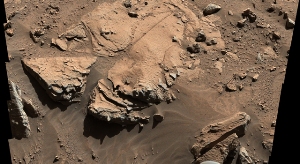Apr 26 2014
The team operating NASA's Curiosity Mars rover is telling the rover to use several tools this weekend to inspect a sandstone slab being evaluated as a possible drilling target.
 NASA's Curiosity Mars rover has driven within robotic-arm's reach of the sandstone slab at the center of this April 23 view from the rover's Mast Camera. The rover team plans to have Curiosity examine a target patch on the rock, called "Windjana," to aid a decision about whether to drill there. Credit: NASA/JPL-Caltech/MSSS
NASA's Curiosity Mars rover has driven within robotic-arm's reach of the sandstone slab at the center of this April 23 view from the rover's Mast Camera. The rover team plans to have Curiosity examine a target patch on the rock, called "Windjana," to aid a decision about whether to drill there. Credit: NASA/JPL-Caltech/MSSS
If this target meets criteria set by engineers and scientists, it could become the mission's third drilled rock, and the first that is not mudstone. The team calls it "Windjana," after a gorge in Western Australia.
The planned inspection, designed to aid a decision on whether to drill at Windjana, includes observations with the camera and X-ray spectrometer at the end of the rover's arm, use of a brush to remove dust from a patch on the rock, and readings of composition at various points on the rock with an instrument that fires laser shots from the rover's mast.
Curiosity's hammering drill collects powdered sample material from the interior of a rock, and then the rover prepares and delivers portions of the sample to onboard laboratory instruments. The first two Martian rocks drilled and analyzed this way were mudstone slabs neighboring each other in Yellowknife Bay, about 2.5 miles (4 kilometers) northeast of the rover's current location at a waypoint called "the Kimberley." Those two rocks yielded evidence of an ancient lakebed environment with key chemical elements and a chemical energy source that provided conditions billions of years ago favorable for microbial life.
From planned drilling at Windjana or some nearby location on sandstone at the Kimberley, Curiosity's science team hopes to analyze the cement that holds together the sand-size grains in the rock.
"We want to learn more about the wet process that turned sand deposits into sandstone here," said Curiosity Project Scientist John Grotzinger, of the California Institute of Technology in Pasadena. "What was the composition of the fluids that bound the grains together? That aqueous chemistry is part of the habitability story we're investigating."
Understanding why some sandstones in the area are harder than others also could help explain major shapes of the landscape where Curiosity is working inside Gale Crater. Erosion-resistant sandstone forms a capping layer of mesas and buttes. It could even hold hints about why Gale Crater has a large layered mountain, Mount Sharp, at its center.
NASA's Mars Science Laboratory Project is using Curiosity to assess ancient habitable environments and major changes in Martian environmental conditions. NASA's Jet Propulsion Laboratory, a division of Caltech, built the rover and manages the project for NASA's Science Mission Directorate in Washington.
The spectrometer on the rover's robotic arm is the Alpha Particle X-Ray Spectrometer (APXS), which was provided by the Canadian Space Agency. The camera on the arm is the Mars Hand Lens Imager (MAHLI), built and operated by Malin Space Science Systems, San Diego. The laser on the mast is part of the Chemistry and Camera instrument (ChemCam), from the U.S. Department of Energy's Los Alamos National Laboratory in New Mexico and the French national space agency, CNES. The rover's wire-bristle brush, the Dust Removal Tool, was built by Honeybee Robotics, New York.
For more information about Curiosity, visit http://www.jpl.nasa.gov/msl , http://www.nasa.gov/msl and http://mars.jpl.nasa.gov/msl/. You can follow the mission on Facebook at https://www.facebook.com/marscuriosity and on Twitter at http://www.twitter.com/marscuriosity.